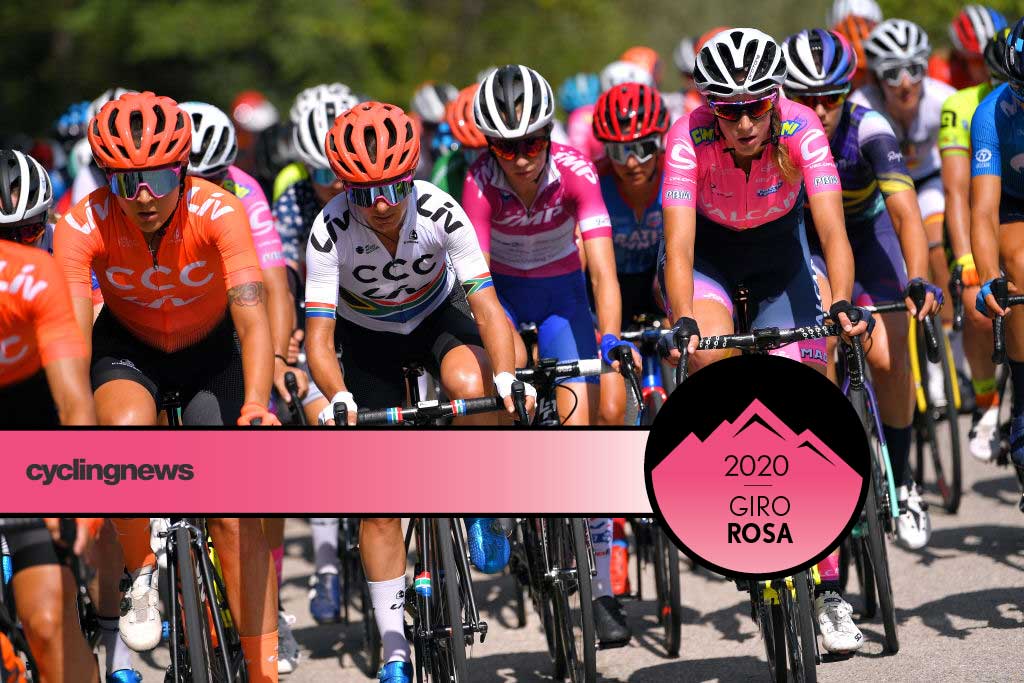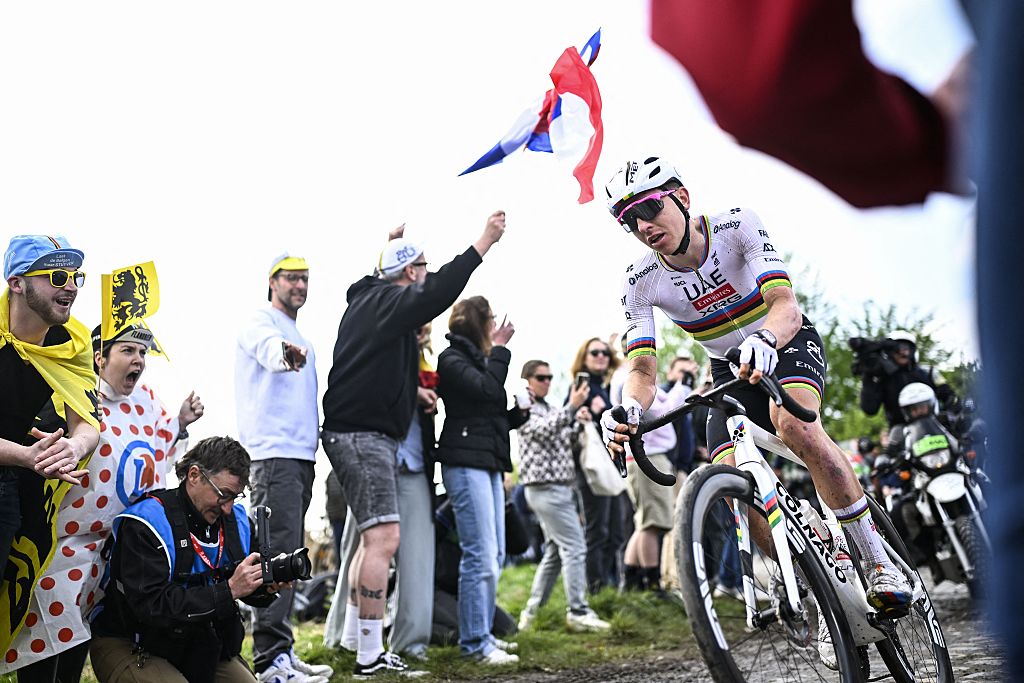Women's peloton breaks through maximum distance barrier at Giro Rosa
170km stage into Tivoli is longest-ever Women’s WorldTour race

The organisers of the Giro Rosa have been criticised for not providing the required 45 minutes of live television during the nine-day race from September 11-19. However, some applauded them for breaking through the maximum race distance barrier set by the UCI during stage 4’s 170km race into Tivoli, while also cautioning that longer races weren't necessarily more exciting.
"Technically speaking, the UCI rules state that we are not allowed to have stages longer than 160 kilometres but today was longer," Ashleigh Moolman-Pasio (CCC-Liv) told Cyclingnews following the stage. "It wasn’t quite [as long] and I looked at my clock, it was just over 165km, plus a neutral zone of 12 kilometres, so it was closer to 180km.
"I think that the women’s peloton is definitely strong enough, in terms of the depth of our potential, and our strength, and the way that women’s cycling has professionalised, we are definitely capable. I think it was an exciting race, at the end of the day. I didn’t feel very different. It was just a little bit longer on the bike. We all train to this level to be able to perform over these distances."
Lizzy Banks (Equipe Paule Ka) was the solo winner of the longest-ever Women’s WorldTour race stage. She was in the breakaway for roughly 85 kilometres, on a day that included upwards of 3,200 metres of climbing and recorded an average speed of 38.2kph, the fastest average speed of any of the road race stages so far.
Banks was in the breakaway with Eugenia Bujak (Ale BTC Ljubljana), who finished second, while Annemiek van Vleuten (Mitchelton-Scott) finished third and increased her overall race lead heading into stage 5 on Tuesday.
"I can’t say that it added anything to the racing," Moolman-Pasio said about the extra distance. "Whether the kilometres were 30 kilometres more or 30 kilometres less, I don’t think it would have made a significant difference to the result. I’ve always been an advocate for the fact that women’s cycling shouldn’t imitate men’s cycling, so I don’t think we need to go any longer than this, but I also don’t see any harm in having some of these longer stages, and in particular at one-day races."
The organisers of the Giro Rosa, celebrating 31 years, have been well known for offering 10 days of racing across the most challenging mountain passes in Italy, such as the Stelvio, Zoncolan and Mortirolo, and the Gavia, which was cancelled from the route late year due to a landslide. This year's route may not be as challenging without an iconic mountain pass, but the 170km stage is in keeping with their commitment to go above and beyond when it comes to tougher racing.
The latest race content, interviews, features, reviews and expert buying guides, direct to your inbox!
Organisers were forced to move the event from July to September due to COVID-19. They announced the full route last month to include a total of four hilltop finishes - stage 3 in Assisi, stage 4 in Tivoli, along with its 170km distance, and stage 8 at San Marco La Catola and stage 9 at Motta Montecorvino.
At that time, Cecilie Uttrup Ludwig (FDJ Nouvelle-Aquitaine Futuroscope) commented on the addition of the distance to stage 4 stating, "Finally, we're being taken seriously, and they don't think our uteruses will fall out if we ride long stages." The Dane finished 7th on stage 4 and is currently in fourth place overall, 3:03 behind Van Vleuten.
In pro road racing, the UCI sets maximum distances for the elite women's and men's one-day races and stage races. The maximum distance for stages in men’s WorldTour events is 240km, while the Professional Cycling Council determines men's WorldTour one-day race distances. Milan-San Remo is the longest one-day event at 305km this year and won by Wout van Aert (Jumbo-Visma).
The UCI sets the Women's WorldTour, started in 2016, one-day races and stages of multi-day events at a maximum distance of 160km, while there is also a maximum average daily distance for stage races that is set at 140km. Also, the Olympic Games maximum distances are 280km for the elite men and 160km for the elite women, and Continental Championships are 240km for the elite men and 140km for elite women.
Women's cycling about aggressive racing, no matter what the distance
While supportive of the longer distances on occasion, Moolman-Pasio cautioned that women’s cycling not try to replicate men’s cycling and said that women’s cycling is celebrated for being more aggressive and action-packed, which is largely due to the shorter distances.
"There’s always the danger that the longer the races become the less exciting it becomes, and I think that is one of the key factors of women’s cycling, is that it is exciting, more aggressive and less predictable than men’s cycling," she said. "I think today’s stage was that, even though it was a longer stage, but I don’t think that the stages need to be any longer or that it should become a common occurrence. I don’t think that the Giro Rosa should suddenly become 170 kilometres every day."
Boels Dolmans directeur Danny Stam echoed Moolman-Pasio, suggesting that the women’s peloton are more than capable of riding further than 160km and he was pleased to see the longer addition to the Giro Rosa. However, he also thinks that organisers should make decisions on route designs that will provide fans a more exciting race to follow.
“I think there is never a question if women can do it,” Stam told Cyclingnews. “For me the question is more about does it make racing more attractive? If you look at the last couple years, women’s cycling have a lot of attractive races. When you make distances longer, it will take longer before finals start.”
Canyon-SRAM’s Elena Cecchini said that the Giro Rosa stages are usually challenging and lengthy, and noted that the peloton raced 124km into Arcidosso on stage 2, followed by 138km into Assisi on stage 3 and then the 170km into Tivoli, a combination that included a lot of good racing.
“In my opinion, the kilometres are not the mirror of good or bad races,” Cecchini told Cyclingnews. “In the end, we had only 10 to 15 minutes extra compared to the three stages before. So, I think we need to consider the three long and really hard days in a row, rather than focusing on just the 170 kilometres of today.”
Despite the efforts of the race organiser to provide a longer stage in this year’s edition of the race, many riders and fans of the sport are rightfully skeptical of how progressive it actually is, particularly when all of the nine stages of the Giro Rosa cannot be seen live on television.
Visit Cyclingnews' dedicated women's page for full reports, results, news, features and galleries from the 2020 Giro Rosa.

Kirsten Frattini has been the Editor of Cyclingnews since December 2025, overseeing editorial operations and output across the brand and delivering quality, engaging content.
She manages global budgets, racing & events, production scheduling, and contributor commissions, collaborating across content sections and teams in the UK, Europe, North America, and Australia to ensure audience and subscription growth across the brand.
Kirsten has a background in Kinesiology and Health Science. She has been involved in cycling from the community and grassroots level to professional cycling's biggest races, reporting on the WorldTour, Spring Classics, Tours de France, World Championships and Olympic Games.
